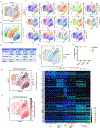Neoantigen-specific CD4+ T cells in human melanoma have diverse differentiation states and correlate with CD8+ T cell, macrophage, and B cell function
- PMID: 35413271
- PMCID: PMC9011147
- DOI: 10.1016/j.ccell.2022.03.006
Neoantigen-specific CD4+ T cells in human melanoma have diverse differentiation states and correlate with CD8+ T cell, macrophage, and B cell function
Abstract
CD4+ T cells that recognize tumor antigens are required for immune checkpoint inhibitor efficacy in murine models, but their contributions in human cancer are unclear. We used single-cell RNA sequencing and T cell receptor sequences to identify signatures and functional correlates of tumor-specific CD4+ T cells infiltrating human melanoma. Conventional CD4+ T cells that recognize tumor neoantigens express CXCL13 and are subdivided into clusters expressing memory and T follicular helper markers, and those expressing cytolytic markers, inhibitory receptors, and IFN-γ. The frequency of CXCL13+ CD4+ T cells in the tumor correlated with the transcriptional states of CD8+ T cells and macrophages, maturation of B cells, and patient survival. Similar correlations were observed in a breast cancer cohort. These results identify phenotypes and functional correlates of tumor-specific CD4+ T cells in melanoma and suggest the possibility of using such cells to modify the tumor microenvironment.
Keywords: CD4; CXCL13; breast; follicular; melanoma; neoantigen.
Copyright © 2022 Elsevier Inc. All rights reserved.
Conflict of interest statement
Declaration of interests S.R.R. is a co-founder of Lyell Immunopharma. J.R.V and S.R.R. have received grant funding and have intellectual property licensed to Lyell Immunopharma. J.R.V. and A.M.H. have received research support from Bristol Myers Squibb. R.G. has received consulting income from Illumina and declares ownership in Ozette Technologies, Modulus Therapeutics, and minor stock ownerships in 10X Genomics.
Figures







Comment in
-
Tracking down tumor-specific T cells.Cancer Cell. 2022 Apr 11;40(4):351-353. doi: 10.1016/j.ccell.2022.03.007. Cancer Cell. 2022. PMID: 35413268
References
-
- Alfaro C, Teijeira A, Oñate C, Pérez G, Sanmamed MF, Andueza MP, Alignani D, Labiano S, Azpilikueta A, and Rodriguez-Paulete A (2016). Tumor-produced interleukin-8 attracts human myeloid-derived suppressor cells and elicits extrusion of neutrophil extracellular traps (NETs). Clinical Cancer Research 22, 3924–3936. - PubMed
-
- Bassez A, Vos H, Van Dyck L, Floris G, Arijs I, Desmedt C, Boeckx B, Bempt MV, Nevelsteen I, and Lambein K (2021). A single-cell map of intratumoral changes during anti-PD1 treatment of patients with breast cancer. Nature Medicine 27, 820–832. - PubMed
Publication types
MeSH terms
Substances
Grants and funding
LinkOut - more resources
Full Text Sources
Other Literature Sources
Medical
Molecular Biology Databases
Research Materials

